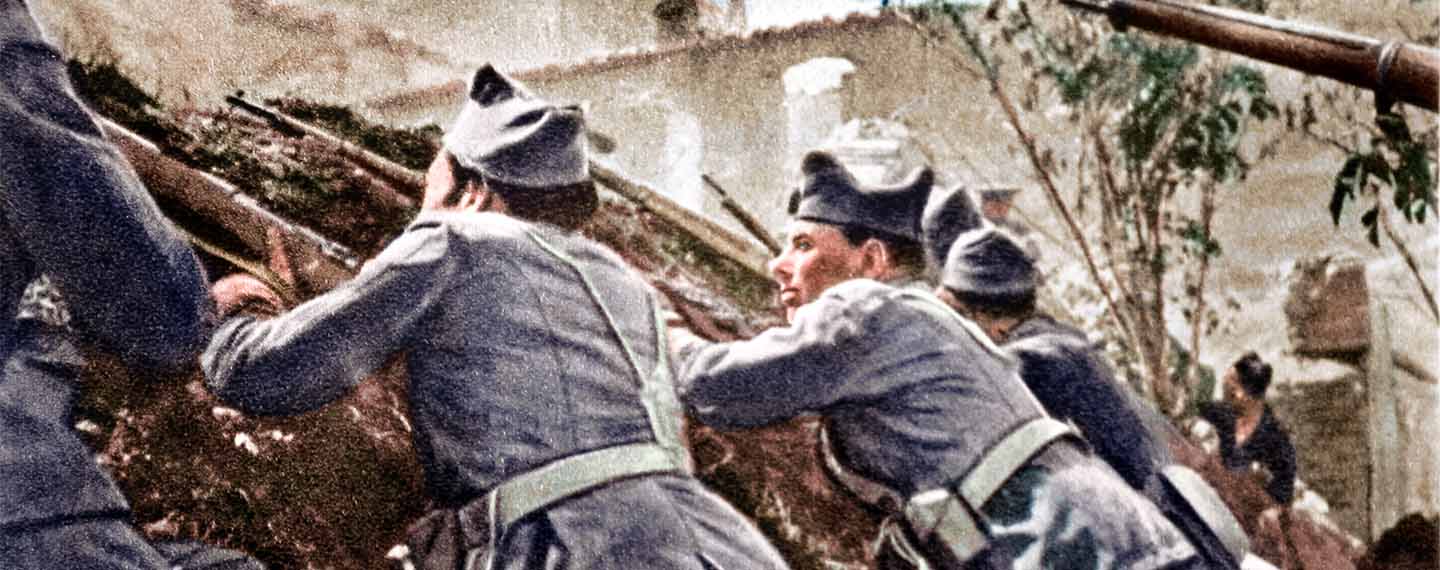Eighteen ninety-eight, a year known by Spaniards as the ‘Disaster’ because of the loss of the country’s last colonies of its once vast empire –Cuba, the Philippines and Puerto Rico– to the US in the Spanish-American war, is a good point at which to begin a history of modern Spain. The defeat galvanised the educated classes into asking why the nation was in seemingly endless decline, sparking analysis of the so-called ‘Spanish problem’ and the need for ‘regeneration’.
The first two decades of the 20th century saw Spain stagger from one government crisis to another until the coup d’état of General Miguel Primo de Rivera in 1923, which broke with 47 years of constitutional government; followed in 1931 by King Alfonso XIII going into self-imposed exile; the establishment of the Second Republic; a civil war (1936-39); the dictatorship of General Franco, the civil war’s victor, until 1975; and a transition to democracy enshrined in the 1978 Constitution.
One of the many virtues of the impressive Penguin History of Modern Spain (Allen Lane) by Nigel Townson, published this month, is that, despite appearances, he shows that Spain was not so profoundly ‘different’ in the 20th century to other Western European countries, or that much of a failure. Spain was distinctive but not that exceptional. Townson, a history lecturer at Madrid’s Complutense University, sets out to correct the country’s somewhat distorted narrative in order to place the country more firmly within the mainstream narrative of European history.
He mines the massive amount of research by Spanish historians since Franco’s death to show, for example, that the country between the turn of the 20th century and the Republic in 1931 was not a time of economic stagnation, social immobility and political polarisation, as has tended to be viewed, but rather one of constant growth, social change and political pluralism, accelerated by the First World War, in which Spain’s neutrality greatly benefited the economy as it allowed the country to supply the needs of the belligerents on both sides. In 1918 Spain became the first country in the world to introduce the eight-hour day, although, in practice, it was largely ignored by employers.
The author makes a good case for the importance of the Primo de Rivera period, which has been generally downplayed as an irrelevant interregnum between the restoration of the Bourbon monarchy in 1874 under Alfonso XII, following the short lived First Republic (less than two years), and the establishment of the Second Republic after municipal elections that were in effect a plebiscite on the monarchy. The reforms in this period, including the building of 8,000 primary schools, produced the biggest fall in illiteracy before the 1960s and help one to better understand the competing forces in the Republic, which erupted with the civil war. One third of the population in 1930, however, was still illiterate and 60% of children received no education at all.
Spain was far from the exception in becoming a Republic. Indeed, it followed those in the previous two decades in, among others, Portugal, Austria, Czechoslovakia, Hungary and Poland. And, like them, it was to be swept away by right-wing authoritarianism.
Townson is even-handed on the Republic. While the restoration of the monarchy and Primo de Rivera’s dictatorship were ‘fiefdoms of the right’, the Republic was one of the left. The latter’s reforms, including a promise to ‘sow Spain with schools’, the right to divorce and granting women the vote, long before France (1944) and Switzerland (1971), were enacted against a toxic mix of heightened expectations, exiguous budgetary resources, a burdensome public debt, global recession, capital flight, militant Roman Catholicism defending its privileges and influence (with the creation of CEDA, the first mass Catholic party in Spanish history), the rise of impatient revolutionaries in the anarchist CNT (15,000 of its members were in jail in early 1934), discontent in the army from cuts to the bloated officer corps (one officer for every nine privates –three times the required number–), and a Civil Guard, defenders of the previous status quo, that used disproportionate force to put down protests. Its standard firearm, the Mauser rife, was capable of killing three people with a single bullet.
In these circumstances, and with no effective political centre to stop things falling apart, it was not surprising that the Prime Minister, Manuel Azaña, noted: ‘We live on a volcano’.
Turning to the civil war, Townson shows that the repression by the Republican side in the first months of 1936 was less ‘spontaneous’ and perpetrated by ‘uncontrollables’ than painted by many historians, compared to that carried out in Franco’s rebel zone in a more systematic and centralised manner. The militia forces took their orders from ‘revolutionary tribunals’ that were not clandestine bodies, and often with the connivance of the authorities. The government was complicit in the shooting of around 2,500 prisoners at Paracuellos: it was clever in covering it up, unlike the massacre perpetrated by the Nationalists in Badajoz.
The book is laced with telling detail. The typical daily ration, for example, for a Nationalist soldier in 1937 was 200 grammes of meat, 60 of olive oil and 50 of sugar, infinitely more than what Republican troops received. A commissar in Madrid reported that a quarter of his Republican troops had no shoes or boots.
The image of Spain as ‘different’ in the 20th century largely stems from the very long dictatorship of Franco, who died in bed. Franco’s New State, on its creation, was not the high point of Spain’s exceptionalism. By 1939, when he had won the civil war, most of Central and Eastern Europe had one form of right-wing authoritarian rule or other, and in Southern Europe not a single democracy survived.
Had the parties that defended the Republic not been so bitterly divided in exile after the civil war, Townson believes the allies after the Second World War might have looked more favourably on unseating Franco, who had done much to support the Axis powers, including allowing their submarines and ships to refuel and be repaired in Spanish ports. However, the onset of the Cold War and Franco proclaiming himself the ‘sentinel of the West’ endeared him to Washington and led to the establishment of US military bases in Spain as of 1953, transforming the regime from a political pariah into a geo-strategic asset.
The economically liberal Stabilisation Plan in 1959 ended autarky and set Spain on a sustained path of strong growth, consumerism and mass tourism, and with it the creation of a large and aspirational middle class that gave the regime stability, but eventually undermined it. It was in the 1960s during the tourism take off that the slogan ‘Spain is different’ was supposedly launched to advertise Spain as an exotic destination. In fact, says Townson, the slogan was introduced in the 1940s and based, paradoxically, on the Soviet campaign of the 1920s: ‘Russia is different’.
It was hard power at home and soft power abroad. While Buñuel’s Viridiana was presented in 1961 as the official Spanish entry at the Cannes Film Festival and won the Golden Palm, it was banned in Spain. Superman, Spain’s best-selling comic, was also banned. A report excoriated the fictitious Clark Kent as an ‘asexual perversion’ for ‘dressing as a woman’ (he donned an apron in order to cook).
The transition to democracy was not as smooth as often assumed, although the process of drawing up a democratic constitution was more consensual than those in Portugal and Greece, again giving the lie to the idea that Spain was somehow different to the rest of Western Europe.
The first heady years after Franco were marked by attempted coups, massive strikes, recession and hundreds of assassinations mainly by the Basque terrorist group ETA (665 deaths between 1975 and 1982, far more than during the Greek or Portuguese transitions).
The worst industrial clash was in Vitoria in March 1976 when police shot and killed five strikers, an event I witnessed as a correspondent of The Times. Gordon Martin, the BBC’s Spain correspondent, was in a flat with his microphone in one hand and a glass of whisky in the other when police fired at the window. He was left holding the microphone and a shattered glass. When journalists tried to hand in a letter of protest to the Civil Governor they were turned back by police, one of whom said, ‘You have democracy in your country, but not in Spain’, adding (translated literally), ‘you come out of my nose’.
Spain has consolidated its democracy, with its particular defects, and has created an admirable welfare state. By the early 1990s Spain had established universal coverage in pensions, education and health, though at a lower benefit level than in longer-established European democracies. The separation of powers, however, leaves much to be desired and the Popular Party (PP) and the Socialists (PSOE), the two main parties, have been plagued by numerous corruption scandals, many of which, strikingly, have been exposed by the press and not public prosecutors.
Townson’s book should become a standard text for students of Spain’s history and, if translated into Spanish as I hope it will be, would also fill a much-needed hole in Spain itself where, generally speaking, schoolchildren study little or nothing of the country in the 20th century and therefore have a very weak grasp of their most immediate, and important, history.
The lack of a national history curriculum in Spain means that schoolchildren nationwide do not have a shared history to draw on. Education is in the hands of regional governments, giving them the power to change 40% of the content of curriculums created by the central government (50% in Catalonia, the Basque Country, Galicia and Valencia, as these regions have co-official languages). Socialist-controlled regions, such as Valencia, give more attention, for example, to contentious periods in the history curriculum, such as the Second Republic and the Franco dictatorship, while those run by the right brush over them or give them a different slant to the one proposed in the government’s guidelines.
The lack of a shared history is one reason why regionalist sentiment is so strong and national sentiment weaker than it should be. Townson’s book would be an ideal textbook for a completely shared history curriculum, should one ever exist.



